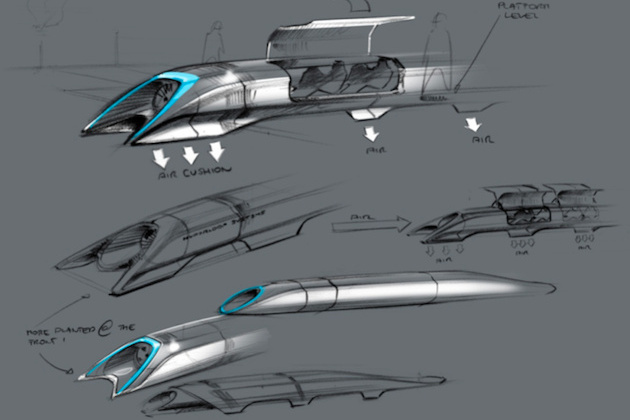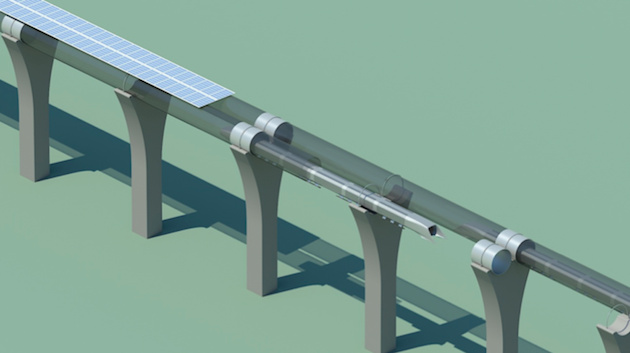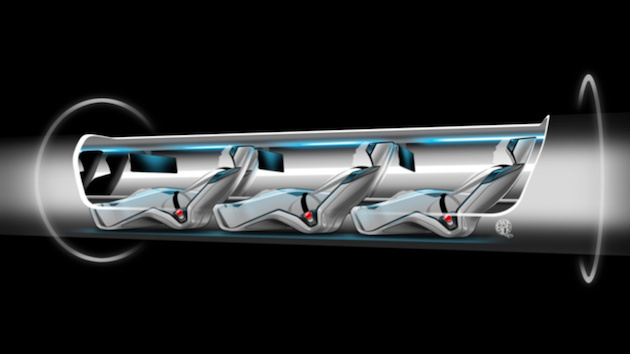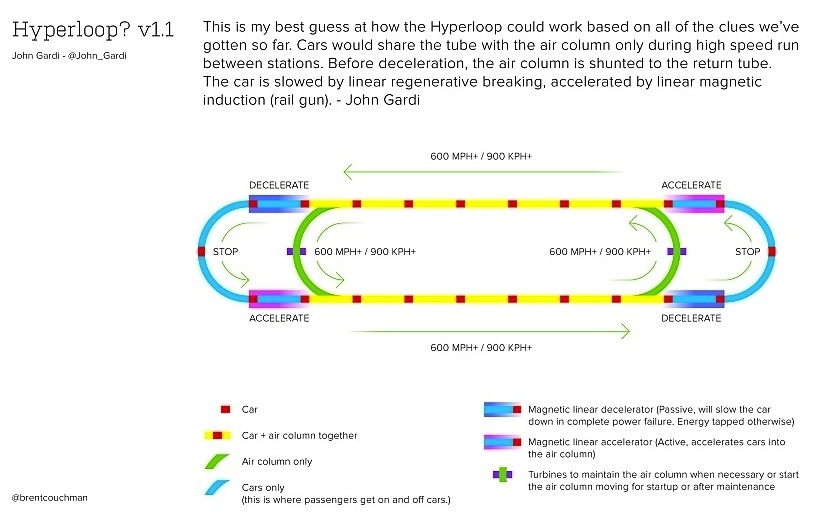
John Gardi is a
tinkerer and jack-of-all-trades currently living in Canada. He
garnered himself a slice of internet fame when he made a mock-up
for Elon Musk's mysterious Hyperloop
transportation system, and Musk himself dubbed it the "best
guess" he'd seen yet. Here, Gardi explains his reaction to the
project's reveal, why the project isn't actually so radical—and how it
can work.
Finally, after much
anticipation, Elon Musk released the preliminary design
for his Hyperloop transportation system. The document lays out
the how and why of the Hyperloop concept in generally understandable
terms. I’ll try to distil it down to the high points here, but the full document won’t tax most
folks. I applaud Elon Musk and the Space X team for that!
We now know for sure that
there really isn’t a loop anywhere in the
Hyperloop transportation system. Each of the opposing
direction tubes is a separate machine which would only share
components, like the pylons holding them up or the power system, for
convenience, not necessity. The two tubes are not connected in any way
other than structurally. The only 'loop' in Hyperloop is in
the perception of the passenger on a return trip. Hyperway
would have been a better descriptive, I think.

How Hyperloop
Will Work
So, lets get right down to the
nitty gritty of what Elon Musk has come up with this
time!
Here’s a breakdown of what
Hyperloop really turned out to be:
- It is a closed
twin tube transportation system providing uninterrupted traffic in both
directions.
- It will be
elevated, as I
speculated in my first article.
No surprise there, it really is the only economical choice. (Don’t give
me too many points for that one!)
- The tubes will be partially evacuated
of air, about 1/6 the air pressure on Mars or equal to an altitude of
150,000 feet in Earths atmosphere, or a partial vacuum.
- The cabins of the pods would therefore
be pressurized with a backup air supply and oxygen masks for
emergencies.
- The pods will be propelled by a rail
gun powered by Hyperloop’s power system. We can
assume solar panels and battery packs here.
- The pods will ride on a cushion of
compressed air powered by batteries in the pod and mostly coast between
the rail gun at each end.
- The pods will travel very fast and
must do so to be efficient. The maximum velocity would be just below
the speed of sound, about 700 miles per hour.
Two different distinct systems
with two different pod approaches are being proposed, not just one:
- The first is an all passenger version
carrying 28 seats.
- The second, I’m assuming larger,
system would carry three automobiles and their passengers.
- The Hyperloop system would split the
power load between the pods batteries and the Hyperloop's own power
systems to maximize efficiency.
The rail gun is
actually a motor split from the outside through to the axle and then
rolled out flat. Well, not really, but I hope it gets the idea across.
The motor is made up of two parts, the rotor, a solid hunk of metal,
usually copper, that the electromagnetic coils, or stators, can grab
onto.
In the case of Hyperloop, the
solid metal rotor will be on the pods—dead weight until the
stators magnetically grab them. The rail gun coils are built into the
tube walls and would be hooked into Hyperloop’s electrical system. The
coils are energized to grab the pods at just the right moment, and
accelerate them down the tube at high speed. The pod
essentially gets a free ride using no more power from its battery than
if it was standing still.
Once the pod is up to its
maximum cruising speed, it coasts on an almost frictionless cushion of
air. This is where the pod needs it’s own power and where Elon Musk’s
design solution becomes really interesting!
This is where Elon Musk left
the rest of us in the dust:
Firstly, there’s that cushion
of air, literally like invisible ball bearings. Elon Musk even calls
them ‘air bearings’ in his proposal. The principle is simple, take the
rails off an air hockey table and flip it upside down so the playing
surface is touching a smooth floor.
Turn it on and it’ll float
slightly above the floor and would probably still
float if you stood on it too. Heavy cargo movers in warehouses work the
same way. In Hyperloops case, the air bearings are only at the bottom
too, not all the way around the pods body as many of us thought it
would be, including me!
So, now you know the basic
principle behind the Hyperloop concept:
- The Hyperloop Tube will be in a
partial vacuum.
- The rail gun will speed the pod up to
maximum velocity.
- The air bearings will allow the pod to
glide almost frictionlessly.

We have everything we need for
a 400 mile coast up the coast in half an hour, right?
Not so fast. Even air pressure
equal to 150,000 feet is thick enough to cause a lot of drag at high
speed. It might be 1,000 times less air pressure than at sea
level but it’s still dense enough to slow you down too much to
make it 400 miles by coasting alone.
So, here’s part two of Elon
Musk’s solution. The pods don’t fill a majority of the tube! So,
instead being like a battery going into a cylindrical flashlight, these
Hyperloop pods are more like a subway or train in a tunnel with lots of
clearance to the tube wall, except at the bottom where the air bearings
are. This way the thin air has a way around the pod instead of pushing
it in front, building up pressure and slowing the pod down. This helps
some but the pod still takes up to much room in the tube to be prevent
a lot of drag.
If we can’t move the pod out
of the way, how about we move the air instead!
The solution then is to have a
large inlet on the nose of the pod, like a post-World War II Saber
jets. Behind the inlet, a set of large turbine blades, just like you’d
see in a dismantled jet engine. take up the whole front end of the pod.
The turbine is spun by a powerful electric motor and it easily
compresses the air and uses it two ways:
- Some of the air is highly compressed
for use in the air bearings. Bottled air can be used as a backup for
the air bearings in case of power failure in the pod.
- Most of the air sucked into the pod is
channeled through the its body around the passenger compartment and
funneled right out the back, just like those old Saber jets!
We have one system doing two
jobs and it’s nice when you can get that! The electric turbine
maintains the compression level for the air bearings and also
eliminating most of the drag by becoming ‘invisible’ to the air,
passing it back as fast as it’s coming—almost!
Now, the last part is pure
elegance itself because it has no moving parts and is the key to
Hyperloop’s uncrashability!

Even though the pod has
reduced drag significantly with the use of the electric turbine, there
is still a stream of thin air moving at very high speed across the top
and sides of the pod. It can’t be helped, if the pod fills the tube
more, it would slow down too fast. So, instead of considering it a
issue, why not use the air outside the pod but inside the tube to our
advantage? By shaping the pod so that the left-over air pushes the pod
down, just like a modern day race car, it will be held to the tube
floor all the more tightly.
Push hard on those air bearing
and they’ll push hard right back. This gives what is often called
authority, a more solid ride and more control. For Hyperloop, more
control is just staying solidly gliding over the tube floor. The very
shape of the pod holds it down during the entire high speed journey.
With no move parts, it provides a primary function and
eliminating a game stopper, un-crashable control for free. Pure Elon!
So, the secret
sauce of Hyperloop really was a complex recipe from a master
chef! By combining those three ingredients, each well known principles,
an elegant overall solution was found. The thin air is used three ways,
the air bearings, the air pass-through to the rear and the air passing
over the pod holding it down.
There’s one more element left
to take care of that last little bit of friction and drag. Insurance if
you will, to make up for any shortfalls. It was the one
part of Hyperloop’s inner tech that I guessed right about and it turns
out to be almost an afterthought,
Let me explain. When I was
researching Hyperloop months ago, I could see that coasting all the way
wasn’t going to cut it, in fact my energy use was embarrassingly high
compared to what we know now. I knew there had to be something to keep
the speed up or boost it periodically. My assumption was to just put a
rail gun along the whole length of the tube, just a lot less dense in
the middle. I could get this to work, but only, as Musk
says, in "non-optimal" circumstances. I was so sure
the sustainer rail gun was there that I actually left it off my
original flow chart for fear of stepping on a billionaire’s
toes.
 The author's original
Hyperloop prediction
The author's original
Hyperloop prediction
I needn’t have worried. the sustainer rail gun sections are there all
right, every 70 miles or so for a few seconds of boost! Elon Musk’s
dynamic solution take up the lions share of the load! And there you
have it in a nutshell, the secret revealed—everything else
about Hyperloop is mundane in comparison!
The mundane stuff
It’s because of Elon Musk’s
brilliant solution that the rest of Hyperloop’s operations fall into
much more familiar territory. Beyond the tight confines and the
blinding speed, Hyperloop is just a modern day rendition of a mass
transit vehicle. It will operate no differently then an elevator or
subway. You get in, go for a ride, get out.
Like a road or railway,
Hyperloop tubes can be used by one pod or many, as much as Tube Traffic
Control can handle. The pods can climb and descend hills like other
mass transit vehicles. Using the air bearing, pods can be as easily
switched as a train, Pod switch yards would look very familiar indeed.
A lot of mass transit knowledge garnered over the decades can be
directly applied to the Hyperloop transportation system.
What have we
ended up with?
In the end, not only did Elon
Musk devise a brilliant technology that was better than any of us
dreamed for, it was such a good design that it brings Hyperloop right
into the realm of familiarity.
Beyond being a unique mode of
travel, Hyperloop is simply just another way to get around.
And that’s just what we want!
By John Gardi









